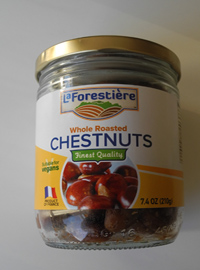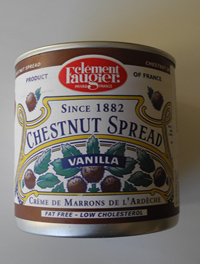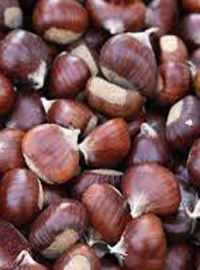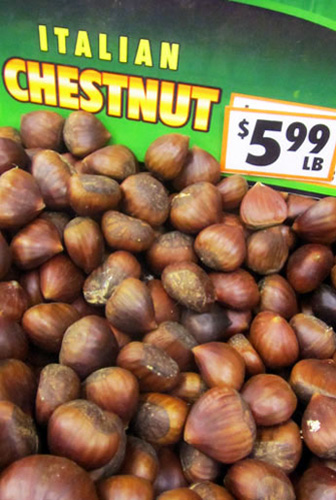Chestnuts 101
"Chestnuts roasting on an open fire. Jack Frost nipping at your nose." The story goes that when Mel Tormé wrote these lyrics for The Christmas Song, it was a sweltering hot July day in LA and he conjured a memory of his Boston childhood and street vendors selling paper cones of roasted chestnuts on a winter day as a way to cool off. The music came later.
For those of us who live in cold weather cities, that slightly acrid smell of scorched chestnut shells, their tender insides roasted and sold on street corners, is indeed a powerful sense memory of urban winters, making it as much romance as a snack. It's no surprise it became a lyric.
In our kitchens, chestnuts are relatively unique in how they can also be a flavor enhancer or the main ingredient. Plus they can be either savory and sweet.
For example, there are (sweet) chestnut cheesecakes, (savory) chestnut soups, (sweet or savory) chestnut raviolis, chestnuts ground into flour for cakes and cookies, chestnuts braised with vegetables, and chestnuts slowly simmered into sugared candies. You can roast them -- over an open fire, of course, but more easily in an oven -- boil them, mash them, or buy them already cooked, puréed, or candied.
What Is A Chestnut?
Chestnuts, as their name suggests, are nuts. But unlike most nuts which store their energy in oil, chestnuts store it in starch, making this nut mealy and meaty with twice the starch (for its weight) as potatoes. So you carb-avoiding folks be warned. They come from large chestnut trees, handsome enough to inspire poets such as Longfellow who must have seen them in his native Maine and certainly also in Massachusetts where he later wrote from his home in Cambridge where today mature chestnut trees still line the streets.
Besides being common throughout North America (although a blight nearly wiped the species out in the early 20th century), chestnut trees are today also found in Europe and Asia, especially China, Korea, Turkey, and Italy. During the peak of harvest season, from October to March, chestnut festivals are held to celebrate this beautiful tree (Castanea sativa) and its burrs that produce up to seven chestnuts each.
Its hard, brown, outer shells and the bitter interior skin must be removed before eating. Moreover the raw nut, high in tannic acid, should always be cooked before eating. Otherwise you are promised a stomach ache. But once cooked, the chestnut is low in fat, and high in fiber and vitamin C.
How To Buy and Store Chestnuts
When buying raw chestnuts, look for ones with shiny, hard shells, avoiding any with cracks or bruises. Choose ones that seem heavy for their size and avoid any that rattle when shaken because this means the nut has dried inside.
Because of their high starch content, chestnuts are perishable. If still in their shells, store them in the refrigerator (perforate the bag to let in air) for about a month, or freeze them (no holes in the bag needed) for up to four months. If you've shelled and cooked the chestnuts (more on this in a moment) you should use them within three or four days; otherwise freeze for up to nine months.
Dried chestnuts, usually sold by the bag, have already been removed from their shells and skin and then dehydrated. They can be reconstituted by soaking in water for about an hour before using them in recipes. But anticipate that dried chestnuts, even when plumped back to normal, are slightly sweeter, have less flavor, and are less meaty in their texture.
Since roasting or boiling fresh chestnuts can take both time and a bit of fuss, you can buy them already shelled, peeled, and cooked and these work well in nearly any recipe. Around Thanksgiving and Christmas you can easily find fresh chestnuts sold by the pound, as well as ones sold in a jar or vacuum-pack that have already been shelled and cooked. But jarred or vacuum-packed chestnuts are also sold year-round. A 7.4 oz. jar of whole roasted chestnuts imported from France that I recently purchased cost $8.99 at Whole Foods.
Chestnuts are also sold puréed, both with and without sugar. One of the best-known brands of sweetened "chestnut spread" is by Clement Faugier, also French, and it's sweetened with sugar and vanilla. A 17.5 oz. jar I recently bought cost $8.99 at Kalustyan's.
Chestnut flour, sold in health food stores and some baking departments in grocery stores, has a strong flavor and is usually used in combination with other flours in cookie and cake recipes. Because it's made from ground nuts, it spoils easily and should be used within a month of purchase; otherwise freeze it.
Chestnut honey, one of the most distinguishable single-flower honeys, has a dark color and an intense flavor that is spicy and slightly bitter. It's sold in specialty stores, often as an import from Italy, and should be stored at room temperature, as with any honey.
Cooking Raw Chestnuts
There are two ways to cook the nuts when you buy them raw in their shells. The first is to roast them, for which you don't need an open fire. First, soak the chestnuts in warm water for about 25 minutes. This will soften the shell. Drain and dry the nuts and with a sharp knife and a steady hand, make an X cut -- all the way through the shell -- on the flat side of each nut. Spread the chestnuts in a single layer on a rimmed sheet pan and roast in a 400° F oven for 20 to 30 minutes, giving the pan a shake a couple of times. The nuts will be done when the shell will have curled back a bit at the X incision and they'll be tender when squeezed. There are numerous videos on You Tube to show how to do this.
You can also boil them. Still pre-soak the nuts and make that X cut in each nut. Place the chestnuts in a pan of cold water, bring to a boil, and briskly simmer until tender when squeezed, about 15 minutes.
The nuts will peel more easily when they're still warm so leave them in the (turned-off but still warm) oven or hot water until you're ready to remove the shell and inside skin.
Some contend that roasting the nuts concentrates the flavor while boiling mellows them. But I can't tell a big difference. However, boiling does change the texture, making them softer and sometimes a bit mushy. If you're planning to purée the nuts, this won't matter but if you want the nuts to remain whole when with other ingredients, roasting may be a better choice.
Cooking With Chestnuts
What I love the most about chestnuts is the meaty texture and subtle flavor and both of these characteristics remain whether I'm using chestnuts as sweet or savory. I associate chestnuts with fall and winter cooking and also with Christmas treats, as with my most favorite candy in the world, marrons glacés.
But first, the savory.
Chestnuts are a satisfying and even luxurious addition to vegetables. When left whole they have a firm, chewy texture that matches well with red cabbage or Brussels sprouts or a winter salad made with chicory and roasted pears. Because their flavor is subtle but complex, they complement instead of dominating other flavors.
In a recipe I made for my Thanksgiving dinner last year, whole chestnuts (I used jarred ones) are braised with red cabbage, sweet Riesling, and a small dice of tangy granny smith apples. The combination of flavors (sweet, musky, tangy, nutty) and textures (meaty nuts, tender cabbage) and colors makes it a brilliant side dish. The recipe is from one of the small volumes produced by Canal House, in this case No. 5, The Good Life. I served it with goose but it would be equally wonderful with turkey or ham. See our link to the recipe.
Martha Stewart has an appealing recipe for a Cauliflower and Chestnut Gratin. A search at her website has many other chestnut recipes, including several for chestnut stuffings.
Chestnuts are also an easy way to add complexity and texture to risotto, as in a recipe from Bon Appétit for Chestnut Risotto. See our links to both recipes.
Because the nuts get soft when cooked, they can be easily puréed into a silky soup or added to mashed vegetables including sweet potatoes. To gild an already luscious dish, finish it with a drizzle of truffle oil.
Now For The Sweet
Chestnuts are a perfect match for sugar. The perfection of a plump marron glacé -- a whole chestnut that has been slowly poached in sugar syrup -- with its whisper-thin shell of sugar would be the final taste on any menu of mine for a last meal. I'd gladly swap any box of chocolates of any size for just one of these sweet prizes.
But marrons glacés are pricey and with a limited season, hard to find except in better chocolate shops during the holidays. A close flavor proximate is chestnut purée sweetened with sugar and vanilla. You can buy this already prepared or you can make your own by cooking raw chestnuts until very tender and then puréeing in a food processor and adding sugar and vanilla, or you could simply sweeten jarred chestnut purée. But the canned sweetened purée, usually called a spread because it contains sugar and vanilla in addition to chestnuts, is quite good and has a luscious texture that is perfect for desserts.
Chestnut flour is sometimes mixed with all-purpose or cake flour to make cookies or cakes. But it's also used alone in gluten-free baking. We found a recipe for a vegan, gluten-free banana bread from a gluten-free cooking blog called Brittany Angell. See our link.
Chestnut honey, with its strong flavor, is perfect to drizzle over thick slices of ripe pears and shards of salty Pecorino Toscano, an Italian sheep's milk cheese with a taste that is similar to but more aggressive than Parmesan.
But the best known and most inspired chestnut dessert is Mont Blanc Aux Marrons. In this classic French combination, meringue shells are filled with sweetened chestnut purée, piped to look like strands of spaghetti piled into a mound, and topped with whipped cream so that it resembles the fabled mountain in the French Alps, its peak capped with snow. In The Cordon Bleu cookbook originally published in 1947 by Little, Brown And Company, author Dione Lucas presaged Julia Child with her book declared as "the finest French recipes from the internationally famous cordon Bleu restaurants and schools, adapted for American home cooks."
I keep my well-worn copy (worn out mostly not by me but by its previous, unknown owners) on the shelf above my desk. Lucas's recipe for Mont Blanc Aux Marrons, made to serve four as was every recipe in her book, uses raw chestnuts cooked in milk, water and vanilla. You could do the same or substitute jarred ones that have already been shelled. She is imprecise about several things (I've added some details in parentheses), including how much vanilla to use; I'd suggest 1/2-teaspoon. And when she writes to "drop meringues," you should use a soup spoon or pastry bag to create four nests of meringues, one for each serving.
3 egg whites
10 tablespoons sugar (superfine would be best)
1 pound chestnuts (in their shells)
Milk (use whole milk)
Vanilla (1/2 teaspoon or more to taste)
1 cup corn syrup
Rum (1 to 2 tablespoons)
Coarsely grated chocolate (optional)
Beat egg whites very stiff; fold in sugar carefully. Fill a pastry bag with plain tube at the end. Put a piece of waxed (or parchment) paper on a cookie sheet and drop meringues on this; sprinkle with sugar and bake in a very slow oven (225° F) until firm and light golden brown. Cool and cover with the following --
Chestnut Purée: shell chestnuts and put in a pan with cold water to cover. Bring to a boil and boil for 2 to 3 minutes. While hot, peel off skins. Put the chestnuts in a saucepan and cover with 1/2 milk and 1/2 water flavored with vanilla; simmer until soft.
Drain and put through a strainer (a potato ricer or several pulses in a food processor would also work) and beat in the following syrup:
Syrup: Put corn syrup in a pan and cook to a fine thread (about 230° F). Flavor with rum (remove from the heat first) and mix carefully into nuts to consistency of mashed potatoes. Fill a pastry bag with a very small, round tube (the size of spaghetti). Pipe carelessly in mounds onto meringues and on top of that pipe rosettes of whipped cream. Sprinkle with coarsely grated chocolate. Arrange on a serving dish and serve.
It's a rich and satisfying dessert and has enough formality to end a fancy meal you may make for a dinner party, something that more of us are doing now that the cooler weather is here and the holidays are coming.
Or you could just spoon sweetened chestnut purée on a scoop of vanilla ice cream, letting the ice cream melt a little so that its creaminess mixes with the thick topping, and raising a spoon of high regard to Henry Wadsworth Longfellow's village smithy:
Under a spreading chestnut-tree
The village smithy stands;
The smith, a mighty man is he,
With large and sinewy hands;
And the muscles of his brawny arms
Are strong as iron bands.
His hair is crisp, and black, and long,
His face is like the tan;
His brow is wet with honest sweat,
He earns whate'er he can,
And looks the whole world in the face,
For he owes not any man….



